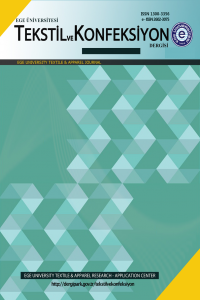The Relief Effects of Thermoplastic Structured-Shrunken Yarns on Woven Fabrics
The Relief Effects of Thermoplastic Structured-Shrunken Yarns on Woven Fabrics
Woven fabric, Shrinking, Thermoplastic Heat-Setting, Relief,
___
- 1. Kurtuldu, E. 2017. Dokuma Kumaş Tasarımı ve Üretiminde Termoplastik Yapılı İpliklerle Rölyef Etkilerinin Araştırılması (Master’s Thesis). Available from www.tez.yok.gov.tr (Thesis Number 469772).
- 2. Acar, S., Meriç D., Kurtuldu, E. 2019. Pleat Effects with Alternative Material and Finishing Methods Tekstil ve Konfeksiyon 29(1), 41-49.
- 3. Handley, S. 2000. Nylon: The Story of a Fashion Revolution. USA: The Johns Hopkins University Press.
- 4. Özkavruk Adanır, E. 2015. Tekstil Lifleri, Özellikleri ve Kullanım Alanları. İzmir: Mungan Kavram Yayınları.
- 5. Huntürk, Ö. 2016. Heykel ve Sanat Kuramları. İstanbul: Hayalperest Yayınları.
- 6. Elsasser, V.H. 1997. Textiles: Concepts and Principles. London: International Thomson Publishing Inc.
- 7. Richards, A. 2012. Weaving Textiles That Shape Themselves. London: Crowood Press.
- ISSN: 1300-3356
- Yayın Aralığı: Yılda 4 Sayı
- Başlangıç: 1991
- Yayıncı: Ege Üniversitesi
Sedat BEHREM, Mahmut KESKİN, Sabri GÜL, Engin ÜNAY, Abdulkadir ERİŞEK
Optimizing the Material-Product Transformation Processes in the Clothing Manufacturing Line
Mehmet KÜÇÜK, Meral İŞLER, Mücella GÜNER
Mutlu KURBAN, Osman BABAARSLAN, İsmail Hakki ÇAĞATAY
The Relief Effects of Thermoplastic Structured-Shrunken Yarns on Woven Fabrics
Performance Characteristics in Textile Application of Photochromic Dye Capsules
Seniha MORSÜMBÜL, Emriye Perrin AKÇAKOCA KUMBASAR
Investigation of Performance Characteristics of 3D Printing Textiles in Terms of Design and Material
Fatma BULAT, Fatma Nur BAŞARAN
Maher ALSAYED, Hatice Kübra KAYNAK, Halil ÇELİK
Safiye Elif KORCAN, Kübra ÇİTEKCİ, Büşra AYDIN, Ahmed Badri ABED, Gülderen UYSAL AKKUŞ
